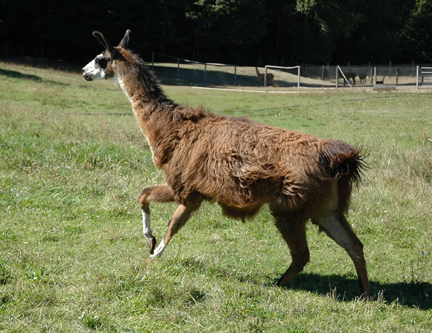Llama care, management and resources
- Llama FAQ
- Llama literature
- Basic care
- Castration
- Spaying
- About breeding llamas
- Handling young llamas
- Misdirected territorial aggression
- How old should llamas be for training and work?
Fiber from llamas
Llamas
as guardians
Classic performance llamas
Communicating
Our llama family
Just for fun
Cria photos
Training consultation
Performance
llama analysis
Princessa's
story
Princessa came to us, and back to us, in an unusual manner. We traveled to California to view a large herd that was to be dispersed because the absentee owner was becoming increasingly ill with an end-stage cancer. A half-sister to one of our best females (Greymist) was on the herd list and we wanted to at least see her. We did not find the half-sister (she was dead), but we did find a huge herd of overfed, malnourished, and otherwise neglected llamas in need. Sadly, we knew we did not have the resources to take them all ... but we strained the resources we had to the limit in order to help a few. The bed-ridden owner constantly changed her mind whether she even wanted to let go of any llamas (granted, she was heavily medicated ... but she also was inclined to "hoard"); we decided to place our emphasis on the llamas who wouldn't be likely to find homes easily.
We rescued and kept or placed five animals from that herd in November of 2002, and then nine more in May of 2003. Princessa was not supposed to be one of those we took in that last group, but she kept standing in front of us and was hard to ignore. We noted that one of her eyes was weepy and held partially closed. Expecting to find an irritating hair or other simple problem, we caught her and were shocked to find she had a huge, infected corneal ulcer. The "caretaker" merely provided hay if and when he felt like it, and we knew from past history that Princessa would definitely not get medical attention and was at immediate risk for losing not only her eye, but her life. We promptly turned out one of the other female llamas (who did not want to go with us in the first place) to make space in the trailer for Princessa. We were prepared to return Princessa or engage in legal proceedings proving neglect and medical need if necessary, but in one of her more lucid moments, the owner agreed over the phone that substituting her for the other llama was a wise action and sent us Princessa's registration papers along with the others.
Princessa's eye received immediate veterinary attention when we arrived home, and after several weeks of intensive care (not to mention a hefty bit of our funds), she recovered with "only" a corneal scar and a moderately small blind spot in her vision from her ordeal. We then placed her less than a half-hour from us with her two maternal sisters, and visited them occasionally.
In late 2006, the couple we'd placed the llamas with told us they were in failing health and needed to sell their home and move into town. In December we retrieved the llamas, intending to place Princessa and her year-younger sister with a farm about an hour north of us that had acquired a lone female and wanted company for her; we planned to keep the youngest sister as a companion for mother Lacy, whose other former herdmates had since passed on. However, after assessing the relative condition of the three sisters, it was clear that Princessa needed different, more susbstantial feed than the other two (perhaps as a result of her restricted vision she wasn't able to defend her food as well) and thus she was a better metabolic match for her aging mother. In addition, all three remembered "mom", but the youngest had outgrown her formerly stronger attachment to Lacy and thus there was no particular point in retaining her specifically. So ... Princessa remained with us instead. We were not sorry things worked out this way, and neither was Princessa!

Princessa runs excitedly out into a different pasture at our farm
(photo 8/07)
Princessa's life took another unexpected twist in late 2008 -- her good eye sustained a trauma (or at least that's we think, and the vets agreed, but no one will ever know for certain) and the eye subsequently infected. Months of treatment later, the only remaining option was to remove Princessa's left eye. Princessa adapted reasonably well (of course she had lost all but reduced light perception in that eye by the time we'd discovered it was compromised, so she'd had quite a bit of time to adapt already); it was also clear that the eye had been painful, and that having it gone was an immediate relief.
Even though we had intended to keep Princessa for the rest of her life (and we enjoyed her antics immensely), her compromised vision produced some pasturing challenges for her and us. Read about the happy solution in Princessa's section of Llamas at Lost Creek Annex!
Return to Lost Creek Llamas home page